
|
|
December 31, 2004 - January 7, 2005
We (Still) Love L.A.: KCRW and some small AMs
It's Tower Site Calendar 2005 season right now here at fybush.com, which gives us a chance not only to showcase the images featured in next year's calendar - but also to do some Very Special Tower Sites of the Week that relate to next year's calendar images...and just maybe, a preview of Tower Site Calendar 2006.
For the last few years, the calendar has featured at least one image each year from one of our favorite markets, Los Angeles. The nation's number-two market (or if you count by revenue, as many LA radio folks do, the number-one market) has a little of everything - nifty directional arrays, huge I-A clear channel AM signals, antique "hammock" AM longwires (KYPA 1230, "Miss November" in the 2005 calendar), and one of the most impressive mountaintop TV/FM sites to be found anywhere.
Los Angeles is also home to some very neat public radio stations. At the University of Southern California, KUSC (91.5) is all-classical, all the time. Pasadena City College put KPCC (89.3 Pasadena) on the air - but it's now operated by none other than Minnesota Public Radio, which programs the station with news and talk for southern California. And out in Santa Monica, Santa Monica College owns KCRW (89.9), which has found a niche for itself in its highly eclectic music programming, interspersed with news and talk both from NPR and from its local staff.
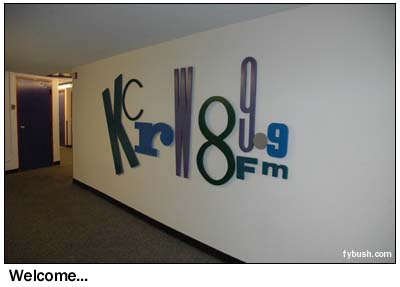 |
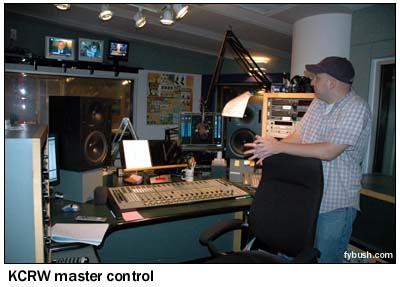 |
We stopped by KCRW on our whirlwind October visit to LA through the courtesy of Will Lewis, the station's management consultant and a veteran of Boston radio in years gone by. For a station that's become an important part of the public radio landscape, KCRW operates from relatively modest physical quarters, taking up most of the basement of the college's student center. Deep window wells bring some natural light down from above, but it's still a basement, albeit one with some awfully nice studios.
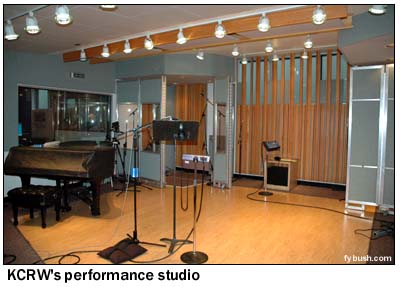 |
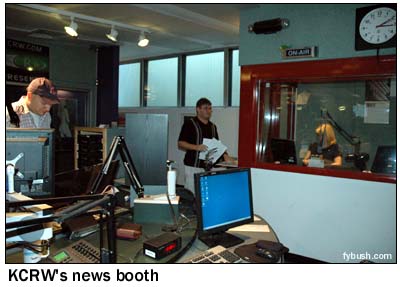 |
The first thing you see when you enter is a hallway that leads down to the performance studio, shown above. KCRW's "Morning Becomes Eclectic" show brings a lot of great performers through here, and the facilities are up to the task - it's no wonder that the CDs of KCRW live performances have become collectors' items. Through the window at the left side of the performance studio is the main air studio, which has a most unusual layout. In addition to the usual U-shaped studio furniture for the jock or master-control operator on duty (including turntables concealed under a panel, for those occasions when the overnight freeform jocks just have to play some vinyl), there's a news booth that's walled off from the rest of the room. And in the corner, there's another U-shaped area with computers and office space for tje KCRW music staff! (The window from the DJ area looks back into the performance studio.)
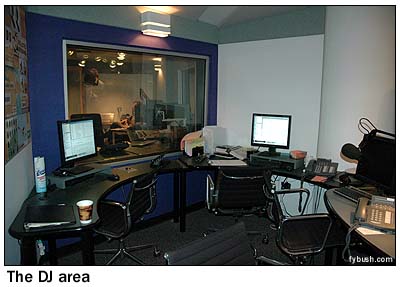 |
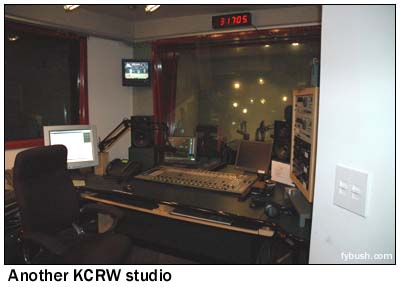 |
Keep going down the hall from the main studio and you pass some office space (never enough, says Will) and the jam-packed KCRW record library on the right. On the left is the small but functional tech area, full of satellite receivers and the back end for the Klotz Digital audio consoles throughout the plant. Tucked way back in a storage area is the rack of remote-control gear for the KCRW transmitter (on a hill a few miles away) and for KCRW's growing network of additional signals in places like Ventura, Palm Springs and the High Desert. That's about where KCRW's space used to end, but with its growth into a national production facility for public radio ("Sounds Eclectic," a weekly version of "Morning Becomes Eclectic") and its addition of more local news and talk programming, the station has pushed down the hall and added more studios. At one point, there was even a big studio back here for the production of radio dramas in conjunction with the BBC, though it's since been subdivided into smaller space.
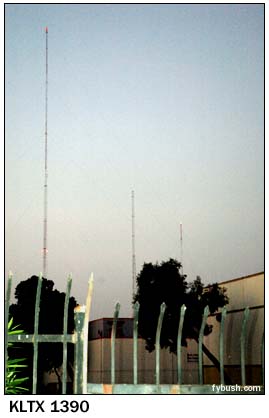
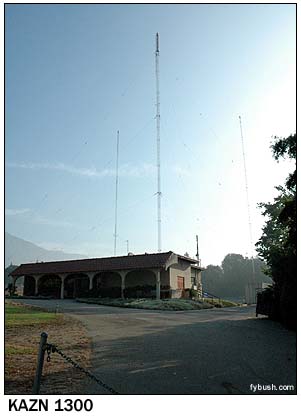 We'll finish up this
week's LA installment with looks at four of the smaller AM facilities
around the region.
We'll finish up this
week's LA installment with looks at four of the smaller AM facilities
around the region.
East of downtown, in Pasadena, there's a long and interesting history to the three towers just north of the 210 freeway. It was once Spanish-language KWKW 1300, one of the first Spanish stations in the market. In the early nineties, KWKW moved to the much better 1330 facility that used to be classical KFAC, and 1300 was sold off to become Asian-language KAZN.
Today, KAZN is owned by Multicultural Broadcasting, as is the facility on AM 1430 a few miles to the south.
Licensed to San Gabriel, this station was KALI for many years before becoming KMRB, which stands (of course!) for Multicultural Radio Broadcasting.
Multicultural has a plan in the works for a big upgrade to this site that would boost KMRB's power substantially; KAZN would also move here, as would (if I'm recalling it right) the facility on 900 that used to be KGRB but now holds the KALI calls.
And we'll close this week with the two AM stations licensed to Long Beach, south of downtown. KLTX on 1390 is the old KGER, and its towers are a few miles north of Long Beach alongside the 710 freeway in Paramount. The 1280 facility in Long Beach has been religious for years, first as KFOX (calls now heard on the 1650 in Torrance) and now as Family Radio's KFRN. We saw its two towers, behind an auto demolition warehouse in an industrial area near the Port of Long Beach, just as the sun was setting off to the west. (For a moment, we savored the triumph of having finally seen every AM site in Los Angeles County, but further thought on the matter reminded us that it's one awfully big county. We're still missing one AM station way, way up north in Palmdale, as well as KBRT 740, 26 miles across the sea on Catalina Island. Someday!)
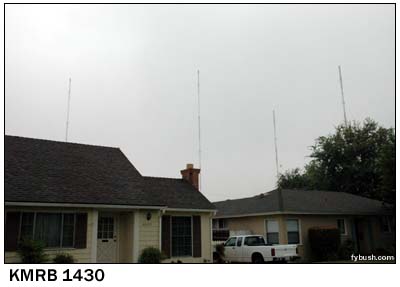 |
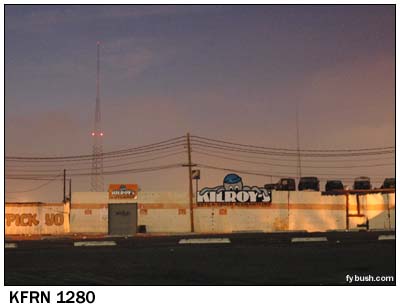 |
 It's here - the 2005
Tower Site Calendar is now shipping! Click
here for ordering information!
It's here - the 2005
Tower Site Calendar is now shipping! Click
here for ordering information!
- Previous Site of the Week: We (Still) Love L.A.: Mount Wilson, part II
- Next Week: San Diego's KOGO, KGB and some North County sites
- Site of the Week INDEX!
- How can you help support Site of the Week? Click here!
- Submit your suggestions for a future Site of the Week!
